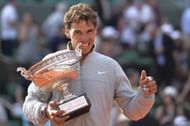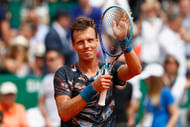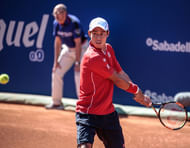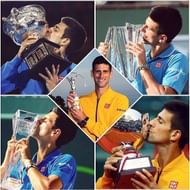8 Grand Slam titles. 143 weeks and counting as the World No. 1. 23 Masters 1000 titles. Any tennis player would be more than happy with these records. Any player not named Novak Djokovic that is.
One title that Djokovic would love to add to his trophy cabinet is the French Open.
The likes of Pete Sampras, John McEnroe, Boris Becker, Jimmy Connors, Stefan Edberg have stumbled on their way to the title in Paris. What does it take to win what many consider the "toughest slam"?
There is no denying the fact that Djokovic can beat anyone on a given day. He has the game to trouble even the best in the business.
Here is what the World No. 1 should do to complete his career Grand Slam.
The Nadal factor
If there is one man who is hard to dislodge on the Parisian clay, it is Rafael Nadal. The Mallorcan denied Roger Federer a shot at glory in three consecutive finals from 2006 to 2008. Nadal beat Federer in the 2011 final as well.
Nadal has an impressive 66-1 win-loss record at Roland Garros. His only loss came against Robin Soderling in the fourth round in 2009.
The Spaniard has handed Djokovic three defeats in the last three years, including two finals in 2012 and 2014. The closest Djokovic came to beating Nadal was in the 2013 semifinals when he led by a break in the decider only to squander it later.
Djokovic has beaten Nadal on clay before. He ended Nadal's 46 match winning streak at the Monte Carlo Masters in 2013 apart from beating the Spaniard at Rome (2011, 2014),Madrid (2011). The Serb dominated their recent meeting in Monte-Carlo as well.
In 2014, Nadal won only two clay titles before the French Open -Rio Open and Madrid Open.
Nadal bounced back brilliantly when it mattered the most in the French Open. Although Djokovic took the first set in the final, Nadal won the match dropping just 11 games in the next three sets.
It's been a case of so near and yet so far for Djokovic as far as winning the French Open is concerned. The Serb is one of the best returners in the sport. If he can improve his first serve percentage on clay and does not let Nadal dictate points on his serve, he has a great chance of going all the way.
Stat attack
The duo have met 19 times on clay, with the Spaniard enjoying a 14-5 lead. Six of those matches were played at the French Open with Nadal coming out on top each time.
Let us first look at the stats from their French Open encounters.
| Match 1: French Open, 2006 Quarterfinal - (Nadal won 6-4, 6-4, Ret.) | Rafael Nadal | Novak Djokovic |
| Aces | 3 | 2 |
| Double Faults | 0 | 3 |
| 1st Serve | 79% | 73% |
| 1st Serve Points won | 63% | 55% |
| 2nd Serve Points won | 58% | 22% |
| 1st Serve Return Points won | 44% | 36% |
| 2nd Serve Return Points won | 77% | 41% |
| Break Points Converted | 71% | 50% |
| Match 2: French Open, 2007 – Semifinal (Nadal won 7-5, 6-4, 6-2) | Rafael Nadal | Novak Djokovic |
| Aces | 3 | 3 |
| Double Faults | 1 | 1 |
| 1st Serve | 70% | 71% |
| 1st Serve Points won | 73% | 57% |
| 2nd Serve Points won | 60% | 37% |
| 1st Serve Return Points won | 42% | 26% |
| 2nd Serve Return Points won | 62% | 40% |
| Break Points Converted | 66% | 33% |
| Match 3: French Open, 2008 – Semifinal (Nadal won 6-4, 6-2, 7-6 (3)) | Rafael Nadal | Novak Djokovic |
| Aces | 0 | 2 |
| Double Faults | 0 | 1 |
| 1st Serve | 72% | 54% |
| 1st Serve Points won | 66% | 57% |
| 2nd Serve Points won | 70% | 58% |
| 1st Serve Return Points won | 42% | 33% |
| 2nd Serve Return Points won | 41% | 29% |
| Break Points Converted | 35% | 33% |
| Match 4: French Open, 2012 – Final (Nadal won 6-4, 6-3, 2-6, 7-5) | Rafael Nadal | Novak Djokovic |
| Aces | 4 | 3 |
| Double Faults | 4 | 4 |
| 1st Serve | 61% | 59% |
| 1st Serve Points won | 61% | 61% |
| 2nd Serve Points won | 53% | 44% |
| 1st Serve Return Points won | 38% | 38% |
| 2nd Serve Return Points won | 56% | 46% |
| Break Points Converted | 52% | 70% |
| Match 5: French Open, 2013 – Semifinal (Nadal won 6-4, 3-6, 6-1, 6-7 (3), 9-7) | Rafael Nadal | Novak Djokovic |
| Aces | 6 | 5 |
| Double Faults | 3 | 2 |
| 1st Serve | 63% | 67% |
| 1st Serve Points won | 71% | 64% |
| 2nd Serve Points won | 60% | 52% |
| 1st Serve Return Points won | 35% | 28% |
| 2nd Serve Return Points won | 47% | 39% |
| Break Points Converted | 50% | 55% |
| Match 6: French Open, 2014 – Final (Nadal won 3-6, 7-5, 6-2,6-4) | Rafael Nadal | Novak Djokovic |
| Aces | 3 | 11 |
| Double Faults | 4 | 3 |
| 1st Serve | 70% | 65% |
| 1st Serve Points won | 72% | 71% |
| 2nd Serve Points won | 50% | 36% |
| 1st Serve Return Points won | 28% | 27% |
| 2nd Serve Return Points won | 63% | 50% |
| Break Points Converted | 60% | 33% |
A couple of things are clear from the above stats. In their last three meetings, Djokovic has been able to stretch Nadal beyond three sets and the points won on the first serve has gradually increased as well.
Nadal has been able to dictate points of his first serve evidenced by the fact that the best first serve return percentage of Djokovic has been 38% in the 2012 final. On the other hand, Nadal has a much better first serve return percentage averaging around the 38% mark, with 44% being the highest in 2008.
Letting Nadal off the hook at critical junctures in a match is the last thing an opponent should do. Djokovic had Nadal on the ropes several times in the past seven years, but couldn’t capitalize on break point opportunities allowing the Spaniard to breathe easy. The Serb had to pay the ultimate price as Nadal more often than not broke back immediately to close out a set.
Now let us look at their most recent match played at the Monte-Carlo semifinals.
| Monte-Carlo Masters 2015 – Semifinal – Djokovic beat Nadal 6-3, 6-3 | Rafael Nadal | Novak Djokovic |
| Aces | 2 | 1 |
| Double Faults | 3 | 0 |
| 1st Serve | 65% | 75% |
| 1st Serve Points won | 58% | 72% |
| 2nd Serve Points won | 47% | 57% |
| 1st Serve Return Points won | 27% | 41% |
| 2nd Serve Return Points won | 42% | 52% |
| Break Points Converted | 33% | 40% |
In this match, Djokovic outclassed Nadal in every department apart from the number of aces. He took the ball early and hit a barrage of backhand down the line winners. The Serb was severe on Nadal’s second serve winning 52% of points as he made deep returns to Nadal’s backhand giving very little time for the Spaniard to react.
Djokovic also hit a couple of forehand service winners of Nadal’s first serve. The two have met 43 times, most in the history of men’s tennis and know each other’s game inside out. Djokovic is one of the best returners on the tour and it will be critical for him to commit fewer unforced errors on his returns to have any chance of breaking Nadal’s serve.
Nadal is clearly the favorite in any baseline exchange on clay and Djokovic will be wary of dropping anything short for Nadal to hit his trademark forehand winner. Nadal is a swift mover on this surface,but a well placed drop shot when Nadal is on the baseline can trouble him as well.
Djokovic won several points with his off-forehand winners in Monte-Carlo recently. It is important for him to place the ball far from Nadal’s reach as the 9-time French Open champion can get around it to hit a curving forehand down the line winner.
A higher first serve percentage is crucial to Djokovic to stay in the hunt against Nadal. The Spaniard will look to pounce on those second serves with a down the line or cross-court winner, whenever he has an opportunity.
At the end of the day, your strategy is only as good as your ability to match the guy on the other side of the net.
Other threats
The World No. 1 cannot take others lightly before he meets Nadal at Roland Garros. David Ferrer is always a difficult proposition on this surface and will be ready to slug it out on a surface he has been brought up on. The Spanish No. 2 has pocketed Rio Open early this year and took a set off Nadal in Monte Carlo. Ferrer made it to the French Open final couple of years ago taking out the likes of Tommy Robredo and Jo-Wilfried Tsonga in the process.
Tomas Bercych has been playing incredible tennis this year. After his win over Nadal in the quarterfinals of the Australian Open, the Czech made deep runs in Indian Wells (semifinals) and Monte Carlo finals. He gave Djokovic a run for his money by sticking to a well thought out strategy.
Berdych used his power baseline game to good effect putting pressure on the Serb’s forehand and followed it up by coming to the net at every opportunity. 2010 Wimbledon finalist hit 51% to Djokovic’s forehand to win four of the five games from 2-3 down in the second set. The World No. 7 was the first player to take a set off Djokovic during the tournament.
Another player who can test Djokovic on this surface is Kei Nishikori. The Japanese made a first round exit in Paris last year, but showed tremendous promise with good performances in Barcelona and Madrid. Nishikori won Barcelona, but had to retire against Nadal in the final set at Madrid. Remember it was Nishikori who took out Djokovic playing lights-out tennis at the US Open last year. He definitely has the game to trouble Djokovic in Paris as well.
Big servers can trouble any player on their day. John Isner who stretched Nadal to three sets in Monte Carlo, is someone Djokovic should be wary about in the early rounds. The Serb’s first loss this year came at the hands of Ivo Karlovic in Doha. The Croat is dangerous when he adopts a serve-and-volley game and is a tough player to lob against!
Milos Raonic, a quarterfinalist in Paris last year can be a handful on clay with his fast serves and powerful ground strokes. US Open champion Marin Cilic took a set off Djokovic in last year’s French Open and can never be written off on the red turf.
The likes of Jo-Wilfried Tsonga, Gael Monfils can pose a challenge, but Djokovic will be able to navigate through them without much of a difficulty. It was Federer who ended Djokovic’s 43-match winning streak in the 2011 semifinals. One of Djokovic’s loss this year came against the Swiss in the Dubai Open finals. Federer in top flight is hard to stop even on clay.
2015 form
Nadal hasn't had a great start to 2015. His win loss record after the Monte Carlo Masters reads 18-6. However, the Spaniard cannot be ruled out just yet. Nadal improves as the clay season progresses evidenced by his results over the last few years.
Djokovic on the other hand, has lost two matches this year. He captured the Australian Open, Indian Wells, Miami Open and Monte-Carlo titles and is a firm favorite to go all the way in Paris this year.
There have been comparisons drawn to the 2011 season, which is by far the Serb’s best year in his career so far. After skipping the Monte-Carlo Masters that year, Djokovic beat Nadal in back-to-back clay court finals in Madrid and Rome before running into a red-hot Federer in the French Open semifinals.
All said and done, this is Djokovic’s best chance at completing a career Grand Slam. The World No. 1 will be the top seed and there is a likelihood of him getting better draws than current World No. 4 Nadal. That could mean a possible semifinal clash between the two. We all know what happened when they last met in a French Open semifinal. Bjorn Borg went on to describe it as the best clay court match he has witnessed in his life.
Nadal has been the best player in Paris by a country mile. But how much longer can he continue to rule Roland Garros? Only time will tell.
For now, Djokovic is at the peak of his game and ever so close to winning the La Coupe des Mousquetaires.
Who Are Roger Federer's Kids? Know All About Federer's Twins




